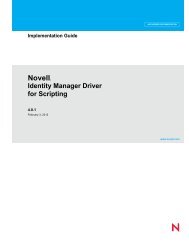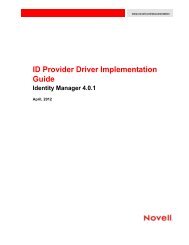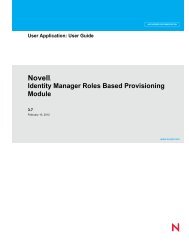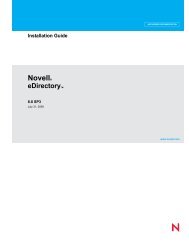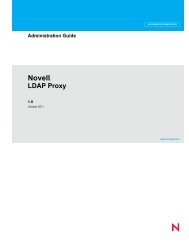Identity Manager 4.0.2: RBPM and Reporting Migration Guide - NetIQ
Identity Manager 4.0.2: RBPM and Reporting Migration Guide - NetIQ
Identity Manager 4.0.2: RBPM and Reporting Migration Guide - NetIQ
Create successful ePaper yourself
Turn your PDF publications into a flip-book with our unique Google optimized e-Paper software.
4 Migrate assigned identities by repeating the following steps for each identity in the list you<br />
compiled before the migration:<br />
4a Select Assign to open the New Administrator Assignment dialog.<br />
4b Select the Role domain.<br />
4c Select identity type (user, group, container or role) <strong>and</strong> lookup the identity.<br />
4d Uncheck the All Permissions check box.<br />
4e Click Assign.<br />
4f Do not close the New Administrator Assignments dialog.<br />
Next, you need to configure the permissions for each user. There was no data security<br />
available for audit reporting in 3.6.1. The 3.7, 4.0, 4.0.1, <strong>and</strong> <strong>4.0.2</strong> releases expose the ability<br />
to secure data by specifying the Report on Role <strong>and</strong> Report on SoD permissions. In order to<br />
setup the same permission set as in 3.6.1, each identity from the list has to get all reporting<br />
navigation permissions <strong>and</strong> the Report On Role <strong>and</strong> Report On Sod permissions for all roles<br />
<strong>and</strong> SoDs. All report permissions <strong>and</strong> report items navigation permission are granted out of<br />
the box via the Role <strong>Manager</strong> assignment.<br />
4g In the Permissions Configuration section, select New to open the Permissions dialog.<br />
4h In the Add Role Permissions section, select the Report On Role permission <strong>and</strong> select all role<br />
levels.<br />
4i In the Add Separation of Duties Permissions section, select the Report On SoD permission <strong>and</strong><br />
select All Separation of Duties Constraints.<br />
4j Click the Save button.<br />
4k Close the New Administrator Assignment dialog by clicking the Close button.<br />
4l Process child roles list by creating a new non-system role, <strong>and</strong> assigning all roles from the<br />
child role list to this role. Assign all users, groups, containers <strong>and</strong> roles from the attestation<br />
manager list to the newly created role.<br />
5 After the migration is done <strong>and</strong> verified, remove the obsolete system roles.<br />
Migrating the Team Permissions<br />
After the User Application driver migration has been completed, you need to migrate the team<br />
permissions. The teams must be deleted <strong>and</strong> recreated. The process of migrating team permissions<br />
involves setting permissions for the newly created (migrated) teams in the User Application.<br />
Alternatively, you can create an LDIF generator utility <strong>and</strong> run it (as described in Section 1.4.4,<br />
“Sample Code,” on page 28).<br />
To migrate team permissions:<br />
1 Login to the User Application as a Security Administrator.<br />
2 Navigate to Administration><strong>RBPM</strong> Provisioning <strong>and</strong> Security.<br />
3 Select Team Configuration in the left navigation menu.<br />
4 Select a team <strong>and</strong> click Edit.<br />
5 In the Permissions section, click New.<br />
6 Under the Add Provisioning Request Definition Permissions section, select the Permissions that<br />
correspond with the permission settings recorded during pre-migration for the current team.<br />
26 <strong>Identity</strong> <strong>Manager</strong> <strong>4.0.2</strong>: <strong>RBPM</strong> <strong>and</strong> <strong>Reporting</strong> <strong>Migration</strong> <strong>Guide</strong>




